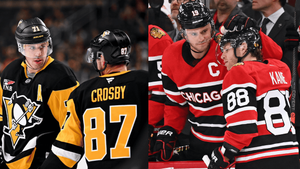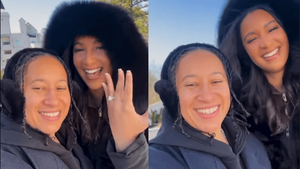It takes less than five minutes into the very first episode of Dreamworks and Netflix's She-Ra and the Princesses of Power to show the audience what it's about. While it takes the whole 45 minutes of the two-part premiere to build She-Ra's central world and its own mythology, the first few minutes focus on the nuanced dynamic between characters Adora and Catra. This shows us, beyond the fantasy elements and the magical worlds that make up She-Ra, what is truly at the center of the show is a relationship between two women.
For its five season run, She-Ra, the reboot of the popular 1980s cartoon, has had a central dynamic at its core: the rivalry between Adora -- who can bring about powerful alter-ego She-Ra -- and Catra, her former best friend who is now working against her. It's a relationship of highs and lows, showing what the two mean to each other, first as friends in an uncertain world, and eventually as foes fighting over the future of the new world. Catra and Adora have an ever-changing, captivating dynamic. It's one that drives the whole series.
It's also very gay.
Another series that strikes a similar chord is AMC/BBC America's Killing Eve. The series, which premiered in 2018 and is currently airing its third season, follows the cat-and-mouse relationship between assassin Villanelle (Jodie Comer) and MI-6 Agent Eve Polastri (Sandra Oh, coincidentally also a voice on She-Ra). Although the tone of the two shows could not be more different, Killing Eve fully revolves around the relationship between its two leads.
Once again, it's very gay.
As someone whose job it is to analyze LGBTQ representation on television, let me clarify. Watching both shows, it seemed very clear to me, and a large portion of queer people on the internet, that the give-and-take relationship between both these pairings, were destined to be romantic. Yet, it was hard not to fall into a familiar anxiety: will they actually end up together?
In terms of She-Ra, a central queer romance in animation isn't completely unprecedented. The Legend of Korra and Adventure Time both ended with an explicit romance between two women with an at-odds dynamic, not to mention the queerness inherent in every part of Steven Universe. And She-Ra itself has already proven to be consistently inclusive, from two princesses in love, to a character's gay dads, to non-binary character Double Trouble. She-Ra has shown a continued commitment to LGBTQ stories. It's helmed by Noelle Stevenson, who is queer herself, as is much of the writing staff.
So, why then, with all evidence in favor, was there a lingering fear inside me that they wouldn't actually get to live out their love for each other?
The answer, of course, rests in decades of queer women being erased, used to tease unrequited relationships, and die as sacrifices or martyrs to forward plots. In recent years, the number of queer characters, and queer women on TV has increased exponentially, but this doesn't negate the patterns before or produce padding for the whiplash of representation.
A significant part of what I do at GLAAD involves studying the evolution of LGBTQ representation in media, and putting that evolution into quantitative values that produce our Where We Are on TV (WWATV) reports. These reports track every single regular and recurring character on broadcast, cable, and streaming television, and provide unequivocal proof that things are changing for the better. Ten years ago, WWATV reported 97 LGBTQ characters accross all platforms. This year, there are over five times that number, with a total of 488 LGBTQ characters. However, knowing these numbers still doesn't stop a voice in the back of my head cautioning it won't happen.
It takes more than a few positive examples and breakthroughs in representation to undercut years of wishing for two women to get together. Even when finally, the well broke and lesbian and bisexual women were popping up on television, they were most often relegated to secondary characters, not leads, and certainly not title characters.
Take, for example, Buffy the Vampire Slayer, a show that broke boundaries at its time through the character of Willow, one of Buffy's best friends whose coming out in the fourth season was revelatory for me watching the DVDs at 13. Later, once I had my own Willow-in-season-four moment, I would watch the series and see something resembling sparks between Buffy and fellow-slayer Faith. But that was something for my teenage gay mind, or thousands of fan-fictions, not something for the actual show to explore. A best friend could be queer, sure, but a title character was a step too far.
Maybe that's why, as I started the fifth season of She-Ra, there was still a looming sense of doubt, that in the history of "will they or won't they," maybe once again, they wouldn't.
If the series premiere took five minutes to establish that this was about Adora and Catra, the final season, and the series finale, shouts from the rooftops that this show is about Adora and Catra. They kiss, they're in love, they save the world, they're undisputedly gay. It tells people like me that our instincts were right from that first episode: this is a love story.
With a show like She-Ra, with its queer staff and rainbows on almost every promotional image, it's hard to tell if this is an especially queer exception or indictive of a larger trend. One sign that points to the latter is the inherent queerness in Killing Eve. As the series, now in its third season, progressed, it became clearer and clearer that the relationship between the two carried a sexual tension and was, in some dark sense of the word, romantic.
My reaction to the beginning of Killing Eve was similar to the beginning of She-Ra: it's very gay, but will the constant subtext actually become overt text? The same worry gripped me, especially since there was not as much of a queer behind-the-scenes presence. Perhaps this would be another situation of watching a show where the leads had undeniable chemistry, but given that they were in fact the leads, nothing besides heated glances would be exchanged.
The way Killing Eve embraced its queerness played out vastly different from She-Ra, given that one is a psychological thriller and one is a fantasy cartoon. There were, however, building blocks of their relationship that couldn't be denied. Villanelle sought out a woman who had the same hair as Eve to take home with her. There was Eve saying "I can't stop thinking about you" in the season one finale, and Villanelle asking Eve to run away with her in the season two finale. Finally, in the third episode of its third season, mid-fight, there is a kiss. This kiss doesn't save the world like its counterpart on She-Ra, but it does confirm what the viewers knew all along: this, too, in its own dark twisted way, is a love story.
Beyond that, both series show that queerness between two lead women is not only possible, it makes for better storytelling. Whether that be the happy ending of Catra saving Adora by saying she loves her, or the messy drama of Eve taking Villanelle by surprise by kissing her on a bus during a fight, both of these point to a future where the title characters may get to live their full queerness. It doesn't have to be imagined in the minds of queer people at home watching. It can be broadcast for the world to see.
It's hard to say what will happen when the next time a Killing Eve or a She-Ra comes along, with two central women at odds who are all but in love. Will I still feel the tension of the show actually representing that relationship in its full queeress? Even with the overwhelming sense of optimism and queerness in the She-Ra finale and the tension in Killing Eve that has anchored the whole show, there was plenty of reason for me to doubt that they would fulfill the potential promised in earlier episodes.
But given the breakneck speed in which television has been becoming more inclusive, I'd like to borrow some of the optimism from She-Ra and hope that as time goes on, and more shows in every genre can exist like them, they will destroy the doubts and fears so many of us have about whether these characters will get to be themselves or find love. Just this week, DC's Harley Quinn saw the central relationship of Harley and Poison Ivy, long erased from film and television, manifest in its full queerness. Months earlier, the CW debuted Batwoman, the first series with a solo lead queer superhero.
As more and more of these examples come up, with queer women as the titular characters, and queer love anchoring the central stories, we can hope that there will be a new wave of queer women who won't have to doubt that their stories have value because they will, in fact, be shown and seen.
Raina Deerwater is an Entertainment Research & Analysis Associate at GLAAD.




































































Charlie Kirk DID say stoning gay people was the 'perfect law' — and these other heinous quotes